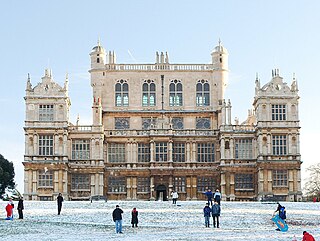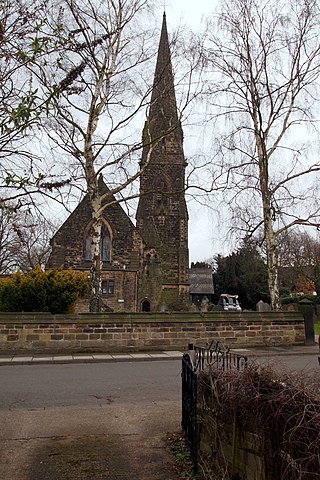Related Research Articles

Francis Willughby FRS was an English Ornithologist, ichthyologist, mathematician and an early student of linguistics and games.

Baron Middleton, of Middleton in the County of Warwick, is a title in the Peerage of Great Britain, created in December 1711 for Sir Thomas Willoughby, 2nd Baronet, who had previously represented Nottinghamshire and Newark in Parliament. It was one of twelve new peerages created together and known as Harley's Dozen, to give a Tory majority in the House of Lords.

Wollaton Hall is an Elizabethan country house of the 1580s standing on a small but prominent hill in Wollaton Park, Nottingham, England. The house is now Nottingham Natural History Museum, with Nottingham Industrial Museum in the outbuildings. The surrounding parkland has a herd of deer, and is regularly used for large-scale outdoor events such as rock concerts, sporting events and festivals.

Middleton is a small village in the North Warwickshire district of the county of Warwickshire, England. The population of the civil parish at the 2011 census was 630.

Wollaton is a suburb and former civil parish in the western part of Nottingham, in the Nottingham district, in the ceremonial county of Nottinghamshire, England. Wollaton has two wards in the City of Nottingham, with a total population of 24,693 at the 2011 census. It is home to Wollaton Hall, with its museum, deer park, lake, walks and golf course.

Wollaton Park is a 500 acre park in Nottingham, England, which includes a deer park. It is centred on Wollaton Hall, a classic Elizabethan prodigy house which contains the Nottingham Natural History Museum, with the Nottingham Industrial Museum in the stable block.

Bramcote is a suburban village and former civil parish in the Broxtowe district of Nottinghamshire, England, between Stapleford and Beeston. It is in Broxtowe parliamentary constituency. The main Nottingham–Derby road today is the A52, Brian Clough Way. Nearby are Beeston, Wollaton, Chilwell and Stapleford. One of the main roads between Nottingham and Derby used to pass through the village centre, entering a cutting that formed a blind bend. A country house to the north of the village became publicly owned and was demolished in 1968. Its grounds became a public area of park and hillside, now known as Bramcote Hills Park.

Bole is a village and civil parish in the Bassetlaw district of Nottinghamshire, England. It is close by the River Trent, on the eastern side of which is Gainsborough in Lincolnshire. At one time the village stood – like the neighbouring parish of West Burton – very near to an oxbow lake, known as Bole Round. However flooding led to the original course of the River Trent being diverted after 1792. The parish now lies within a landscape largely dominated by the West Burton power stations. According to the 2001 census Bole had a population of 140,a count of 247 at the 2011 census, and singularly reported as 135 in 2021.

Bluecoat Aspley Academy is a Church of England secondary school and sixth form located in the Aspley area of Nottingham, England, dating back to 1706. In 2007, the school had 1550 students aged six to eighteen, including 250 Sixth form students. Prior to receiving Academy status in January 2012, the school was titled The Nottingham Bluecoat School and Technology College.

Annesley Hall is a Grade II listed country house near Annesley in Nottinghamshire, England and the ancestral home of the Chaworth-Musters family. The 13th-century park, 17th-century terraces and 19th-century pleasure gardens and walled gardens of the hall are Grade II* listed on the Register of Historic Parks and Gardens.

Lenton Abbey is a large housing estate, forming a neighbourhood in Nottingham, close to Wollaton, Beeston and the University of Nottingham.
Manuscripts and Special Collections is part of Libraries, Research and Learning Resources at the University of Nottingham. It is based at King's Meadow Campus in Nottingham in England. The university has been collecting manuscripts since the early 1930s and now holds approximately 3 million documents, extensive holdings of Special Collections, and the East Midlands Collection of local material, all of which are available for researchers to use in the supervised Wolfson Reading Rooms.

St Leonard's Church is a Church of England parish church in Wollaton, Nottinghamshire, England. Dating originally from the 13th century, the church was restored in the Victorian era and again in the 20th century. It is notable for the large number of funerary monuments it contains. Many are to the Willoughby family, of nearby Wollaton Hall. There is also a memorial to Robert Smythson, designer of the hall, and one of the first English architects. The church is a Grade II* listed building.

St Andrew's Church, Langar-cum-Barnstone, is a parish church in the Church of England in Langar, Nottinghamshire. It is Grade I listed as a building of outstanding architectural or historic interest.

Colwick Hall was an English country house in Colwick, Nottinghamshire. It is now a hotel. The building is Grade II* listed.

Wiverton Hall is an English country house near Tithby, Nottinghamshire in England. By 1510 the former village of Wyverton had become impoverished and reduced to just four houses and a cottage. It was in that year completely depopulated by "emparkment", when George Chaworth enlarged his park by 254 acres. All but the Grade II* listed gatehouse of the mansion was destroyed in the English Civil War. The current house dates from 1814. The location is also the centre of a wider civil parish with the same name, which had 41 residents at the 2021 census.
George Chaworth, 1st Viscount Chaworth of Armagh was an English politician who sat in the House of Commons between 1621 and 1624 and was raised to the peerage as Baron Chaworth and Viscount Chaworth.
Sir Thomas Chaworth was an English landowner and Member of Parliament. He and his second wife, Isabel Chaworth, became one of the richest family's in England when his wife unexpectantly inherited the estate of Hugh Aylesbury of Milton Keynes.
Bridget Chaworth, later Bridget Carr, was a gentlewoman of the Privy Chamber to Elizabeth I and Queen Anne.

Sir Henry Willoughby was a Knight of the Body to Kings Henry VII and Henry VIII and MGO.